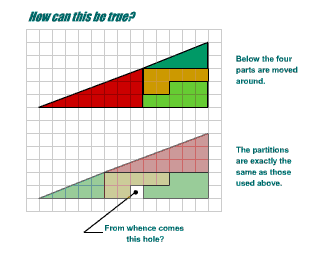Muggles, Logo and gradients
Image

| We shall use Logo to throw some mathematical light on the Muggles Magic problem. How can the same four pieces in the jigsaws on the left be placed as shown and leave an extra square hole in the lower arrangement? Look at the diagram on the left, try to explain the 'magic' mathematically for yourself, and then read on.
The Logo programs below show you very accurately the difference in the gradients of the longest sides of the two right angled triangles.
First Forward into Logo is a twelve part introduction to Logo for beginners. |
The line joining the point $(0,0)$ to the point $(x,y)$ has slope or gradient $y/x$.
The larger the number $y/x$ the steeper the slope.
If $y/x=1$ then the angle of the slope is $45^\circ$.
If $y/x < 1$ then the angle of the slope is less than $45^\circ$.
If $y/x > 1$ then the angle of the slope is greater than $45^\circ$.
MUGGLES SLOPE1 what happens?
Yes you get a right angled triangle with angle of slope ARCTAN 5/13, because the sides are 650 across and 250 up (the triangle with sides 13 and 5 enlarged). Can you see what the scale factor is? To draw the hypotenuse, the SLOPE1 program uses Pythagoras Theorem to work out the length and then multiplies it by the scale factor.
The programs SLOPE2 and SLOPE3 draw the hypotenuses of the two small triangles in the Muggles jigsaw.
The angles in these triangles are shown by: SHOW ARCTAN 3/8 SHOW ARC TAN 2/3 and the angle in the large triangle is shown by: SHOW ARCTAN 5/13
The gradients of the sloping lines are 0.375, 0.4 and 0.385 (to 3 decimal places).
The sequence of programs MUGGLES SLOPE1 SLOPE2 SLOPE3 shows the sloping sides of the triangles as arranged as in the upper jigsaw
and MUGGLES SLOPE1 SLOPE3 SLOPE2 shows the sloping sides of the triangles as arranged as in the lower jigsaw. | Image
| TO MUGGLES CS ;SETPOS places the cursor using coordinates SETPOS[-200 0] RT 90 FD 650 LT 90 FD 250 END
TO SLOPE1 ;MAKE "A gives a value to the variable :A MAKE "A 13*13+5*5 MAKE "B SQRT :A ;note the use of Pythagoras Theorem here PU SETPOS[-200 0] PD RT 90 ;(ARCTAN x y) gives the angle whose tangent is y/x LT (ARCTAN 13 5) FD 50*:B ;the turtle draws a line with slope y/x PU SETPOS[-200 0] PD RT (ARCTAN 13 5) ;now the turtle points in the x direction END
TO SLOPE2 MAKE "A 3*3+8*8 MAKE "B SQRT :A LT (ARCTAN 8 3) FD 50*:B RT (ARCTAN 8 3) END
TO SLOPE3 MAKE "A 2*2+5*5 MAKE "B SQRT :A LT (ARCTAN 5 2) FD 50*:B RT (ARCTAN 5 2) END |
